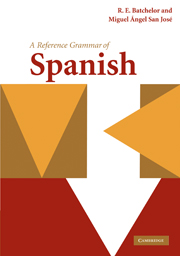Book contents
- Frontmatter
- Contents
- Preface/Prólogo
- Acknowledgments/Agradecimientos
- Abbreviations/Abreviaturas
- Introduction to the Spanish language/Introducción a la lengua española
- Part I
- Part II
- Part III
- Part IV
- Part V
- 56 Personal pronouns/Pronombres personales
- 57 Possessive adjectives and possessive pronouns, and usage with parts of the body and clothes/Adjetivos y pronombres posesivos, y uso con partes del cuerpo y ropa
- 58 Relative pronouns/Pronombres relativos
- 59 Interrogative pronouns and adverbs/Pronombres y adverbios interrogativos
- Part VI
- Part VII
- Part VIII
- Part IX
- Part X
- Appendix I Verb tables/ Tablas de verbos
- Appendix II Glossary/Glosario
- Bibliography/Bibliografía
- General index/Índice general
- Subjunctive index/Índice del subjuntivo
56 - Personal pronouns/Pronombres personales
from Part V
Published online by Cambridge University Press: 05 June 2012
- Frontmatter
- Contents
- Preface/Prólogo
- Acknowledgments/Agradecimientos
- Abbreviations/Abreviaturas
- Introduction to the Spanish language/Introducción a la lengua española
- Part I
- Part II
- Part III
- Part IV
- Part V
- 56 Personal pronouns/Pronombres personales
- 57 Possessive adjectives and possessive pronouns, and usage with parts of the body and clothes/Adjetivos y pronombres posesivos, y uso con partes del cuerpo y ropa
- 58 Relative pronouns/Pronombres relativos
- 59 Interrogative pronouns and adverbs/Pronombres y adverbios interrogativos
- Part VI
- Part VII
- Part VIII
- Part IX
- Part X
- Appendix I Verb tables/ Tablas de verbos
- Appendix II Glossary/Glosario
- Bibliography/Bibliografía
- General index/Índice general
- Subjunctive index/Índice del subjuntivo
Summary
Below is a passage narrating a conversation between an engaged couple and a priest. The couple are Argentinian, which explains the use of vos and the corresponding verb. The passage shows the use of personal pronouns. The couple want photographs taken in the church, although they are getting married at city hall. The priest says the only person who can give permission is already in the church: el Jefe.
–¿Deseabais algo? Hoy me he olvidado la agenda y no recuerdo si había quedado con vosotros; no me acuerdo si os he citado o no –les dijo el cura que salía en aquel momento de la iglesia–. ¡Ah, perdón! Quizá no les conozca (a ustedes)…, creo que no son de esta parroquia (parish)… Bueno… ustedes dirán (lo que desean)…
–Buenos días; no nos conoce usted. Mi prometida (fiancée) y yo somos argentinos. Vivimos a dos cuadras de acá (two blocks from here). Nos queremos casar el lunes en el ayuntamiento y sería lindo nos tomaran unas fotos en su altar mayor para la familia de allá, –luego, dirigién-dose hacia ella, trasluciendo (revealing) un acento influido por años viviendo en Madrid–. Vos decí (A) algo, si vos consentí (A). Vos sos (A) la novia (fiancée), hablá (A).
–No, el consentimiento lo dan ustedes en la boda. Aquí no. Yo no tendría inconveniente en dejarles hacer la foto, pero es engaño a la familia que no cuadra (does not fit) con el lugar.
[…]
- Type
- Chapter
- Information
- A Reference Grammar of Spanish , pp. 301 - 315Publisher: Cambridge University PressPrint publication year: 2010



